Let’s start with Bakhmut this time, and extrapolate out from there, since Bakhmut is the current central point of the war from which everything flowers outward.
Firstly, Zelensky has just given his most candid answer in an interview, about the true importance of keeping Bakhmut. It strikes a harsh contrast to all the previous propaganda, including from him, that Bakhmut was a city of ‘little strategic importance’:

He states, in short, that if Ukraine loses Bakhmut, immense international pressure will be put on Ukraine to make compromises and presumably sign ceasefires, etc.
"If Ukraine loses Bakhmut, pressure will begin on Kiev and we will no longer be respected all over the world" -Zelensky in an interview to the Associated Press
He also states that the Ukrainian society will grow ‘tired’ and push Zelensky to sign a deal, hinting at a catastrophic morale loss that could spell doom for the AFU. If one reads between the lines, it’s clear to see that Bakhmut is being treated as an existential ‘last stand’ by the AFU. And so it becomes clear as to why they’re withstanding abhorrent losses of now possibly tens of thousands in Bakhmut alone.
And that’s not an exaggeration. Bakhmut has been fought over since late last year, however the ‘intense phase’ began this January. We know from the AFU’s own words that they lose several hundred men there per day—between 200-500, give or take. By mid-March or so, it would have been 3 months, or 90 days, of intense fighting there at this scale. 90 x 200 per day = 18,000 dead. If you take the higher estimate of 500 per day, you get 45,000 dead. And this is not counting the lower scale fighting there in previous months. In short: Zelensky has sacrificed likely at least 10-20k troops in Bakhmut, if not much more.
I outlined in previous reports why Bakhmut is so important, besides the reasons Zelensky gave above. Which is that after Bakhmut falls, it opens up a clear path to the AFU’s final stronghold of the Kramatorsk/Slavyansk agglomerate. The AFU are obviously signaling that their defensive lines in the sparse/open regions between Bakhmut and Kramatorsk would not hold long to Wagner’s onslaught, so they are doing everything in their power to try to ‘contain the beast’ there at this final stand.
And now Zelensky may be prepared to sacrifice even tens of thousands more if the mega counter-offensive on Bakhmut materializes.
However one new rumor has stated that the ‘Western’ controllers have forbidden Ukraine from using their spiffy new tanks (Challengers, Leopards, etc.) in the Bakhmut theater. It appears the West wants those to be saved for the grand southern counter-offensive. This could also signal the confirmation that the West views the Bakhmut defense as futile, and wants Zelensky to give it up—which, if true, gives us a little insight into the current strategic thinking behind the scenes. This would suggest that it’s Zelensky’s personal insecurities driving this Bakhmut bloodbath—the very same insecurities on full display in the interview above where he fears that his people will lose hope. But by all indications, many of the top western military leaders have signaled that they prefer for Bakhmut to be abandoned and that Ukraine is paying ‘too high a price’ for its defense. These are interesting insights.
Here’s a few disparate updates regarding the upcoming counter-offensive:
Mass vacations in the Armed Forces of Ukraine. What does it mean?
According to sources of "Go and see", soldiers of the Armed Forces of Ukraine are massively sent on leave and furloughs. In terms of the total number of "vacationers" - this is a record since the beginning of the SVO. "To date, we know about a record number of furloughs and vacations for military personnel. This is also noticeable in the rear, " said one of the channel's interlocutors.
The fact is that a similar situation was observed last fall. After mass vacations, a counteroffensive began in the Kherson direction. Given the average vacation length per week, it's not hard to guess when the Ukrainian offensive is expected this time.
Ukraine is saving up ammo:
It is noted that the enemy has recently reduced the attacks with "Himars", saves artillery and equipment. A counteroffensive by the Ukrainian Armed Forces is expected between April 15 and May 9. Much depends on its outcome. In addition, the APU will not have the same strike capabilities for a long time, and this only increases the stakes.
However what’s interesting on that account, is that Russian ammo stocks, too, have been accumulating for something large:


One thing that needs saying about the spring offensives, is that Russia here has a distinct advantage of time. You see, there is no pressure on Russia to launch an offensive, no time ticking down to an unspoken ‘deadline’ in the same way there is for Ukraine. Ukraine has to show its Western partners something big and successful or support will wither away. Even if it’s not ready and stands no chance, Ukraine must launch a major action within the next month or two. Zelensky himself stated yesterday that without continued US support, Ukraine will lose.
But Russia has no such constraints or deadlines. So how does that give it an advantage? The analogy is the following: if you’ve backed someone into a burning building, and there is only one main exit, and you have it covered, then you know he has to come out of that exit, and soon. There is an advantage in knowing your enemy’s options and their exact timeline. That means Russia can leisurely sit back and continue accumulating resources, stockpiling its weapons and preparing the ground stakes and abatises for Ukraine’s impending, telegraphed cavalry charge.
Normally, two sides like this could play a game of hesitation, waiting each other out to see who would make the first move and ‘over-extend’ so that he can be counter-acted and destroyed. In modern warfare, defense is much easier to successfully conduct than offense (well that was likely always the case, but it’s exponentially more so now).
However, now Ukraine has no choice. They must make the first move and this puts them at a severe disadvantage. Particularly because should that first move end disastrously as the likely case will be, it will sap all their troops’ combat potential, both exhausting them and destroying their fighting capability, which will immediately make them ripe for Russia’s own mass over-running advances.
Like I said, for now Russia can sit back and inch forward leisurely, conserving its strength, building up stockpiles. On that note, we had an interesting insight from Putin a couple days ago, where for the first time he stated that Russia produces ‘three times more’ shells than the entire West is able to give Ukraine. He also quoted the well-known number of US’s 14,000 per month shell production.
I’ve covered this in depth previously, outlining all the numbers, and coming to the conclusion that the West can likely supply somewhere between 100-150k shells per month to Ukraine. I won’t go through all the numbers again, if you’re interested you can reference my previous detailed article on this:
But suffice it to say, my calculations concluded that, discounting full ‘ramped-up’ capacity, which would take 2-3 years to reach (180k+ shells per month), the West currently can likely only do 100k or less, while Ukraine shoots off 180k per month (~6000 a day x 30 days).
In fact, as of this writing a new report just came in hot off the wire which states:
▪️About increasing the production of ammunition in NATO countries
▪️ The United States plans to increase production of 155mm rounds to 85,000 per month by fiscal year 2028, six times the current rate, said the U.S. Deputy Secretary of Defense.
▪️ Slovakia has also begun expanding its industrial capacity to increase its production of 155mm artillery shells from 30,000 to 100,000 per year. Moreover, according to the country's defense minister, with the support of the EU, it is possible to reach the figure of 150,000 ammunition annually.
So, according to Putin, Russia is currently producing 3x the capacity of the entire West which likely puts Russia at somewhere around 300k shells per month. In the article above, I estimated that Russia can produce somewhere between 3-7 million shells per year. 300k per month is exactly 3.6m per year, so my calculations were correct there as well.
However, this is still very problematic for Russia. At even 20k shells per day expenditure, which apparently is the ‘low end’ (sometimes 50-60k), that’s 7.3m shells per year, which clearly is a massive deficit.
There were statements by several AFU officers last month that since November/December of last year, Russia had even dropped off to firing about 10k shells a day, which would match the exact 300k per month or 3.65m per year number. So that’s likely Russia’s current break-even amount. It’s still double that of what the AFU can fire, but not enough for Russia to enjoy the overwhelming artillery ‘shock and awe’ of 50-60k shells per day usage.
However, we can only assume Russia is also ramping this up and perhaps will achieve a 7m+ per year number within a year or so, and maybe by 2024 will return to firing much higher volumes. On this count, Shoigu recently visited Russian shell factories in Kirov and Chelyabinsk:
Alt link for those without Twitter: VIDEO
NATO will ramp up also, but as already calculated in my mentioned previous article, they can get to maybe 180-200k shells per month in 2-3 years time, which is still a pittance. Just look at this news alert from yesterday:
From the end of March, France will double the supply of 155 mm shells to Ukraine. Currently they supply 1000 shells which will increase to 2000 shells.
With that said, it’s still a large artillery advantage for Russia, but the big, natural question is: is it enough of an advantage to enable Russia to truly progress forward and achieve its objectives of totally demilitarizing/conquering Ukraine? Some could argue that to have rough artillery parity would only result in a stalemate situation. To have 2:1 advantage perhaps might still not be enough, seeing as how even with 5:1 previous advantage Russia was still not achieving massive break throughs.
So this remains to be seen, however there are many other variables which should enable Russia to proceed successfully, such as a much larger percentage of munitions in general now being guided ones than before.
For instance: a new update has emerged from Bakhmut that Wagner is now regularly using an advanced laser-guided 120mm mortar called KM-8 Gran:
Wagner Forces Using KM-8 Gran 120mm Guided Mortar Shells To Sever Supply Lines to Bakhmut Wagner PMC gunners are reportedly using Gran 120 mm gliding SALH (Semi Active Laser Homing) shells to sever Ukrainian supply lines to Bakhmut, instead of long range artillery.
With the main highways taken, AFU is using narrow winding country roads to supply its forces in Bakhmut. The KM-8 "Gran" system can be used with smooth-bore and rifled 120 mm calibre mortars for the destruction of single and group targets or fortifications.
Its 120mm guided shell features a high-explosive warhead designed to engage armoured & unarmored vehicles and artillery pieces. Using Gran it's possible to engage targets moving in narrow passes located behind the high crests of shelters including on their reverse slopes, with precision during day or night. Typically, to successfully engage a target in a hard-to-reach area a gun crew at a distance of 6 km would need to fire 100-200 regular shells.
Using Gran gliding SALH shells, Wagner PMC crews are able to destroy the target with just one or two shells. The target can be laser illuminated by the combat vehicle with the firing mortar, a reconnaissance spotter, or a UAV.
The Malakhit automated artillery fire control system (AAFCS) provides target detection and illumination (including at night), survey control of the fire position and command observation post, automated calculation and firing data input.
Multiple shells fired with the same mortar setting can strike different targets 300 m apart, homing on to the currently illuminated target. The 1.2 m long Gran shell has a mass of 27 kg, its warhead weighs 11.2 kg with a 5.3kg explosive charge of 5.3 kg. Range - 1.5 to 9 km.
This could explain all those videos of Bakhmut supply line road destruction.
To summarize: by producing and using more guided munitions, Russia is able to retain the same effectiveness but with far less total shells. So the total shell numbers can be misleading as Russia is becoming more and more technological in its war approach and subsequently ‘using less to achieve more’. As the above quoted writeup highlights, using the Soviet grid system of artillery could take upwards of 200 shells to fully destroy a given target, whereas the guided shell can do it in 1 or 2.
Also, there’s increasing evidence of Russian guided bomb usage from the airforce. I’ve outlined in detail previously about the various new types of glide-bombs Russia is using, but we have ever more confirmation now, including Ukrainian Air Force spokesman Yuriy Ignat:

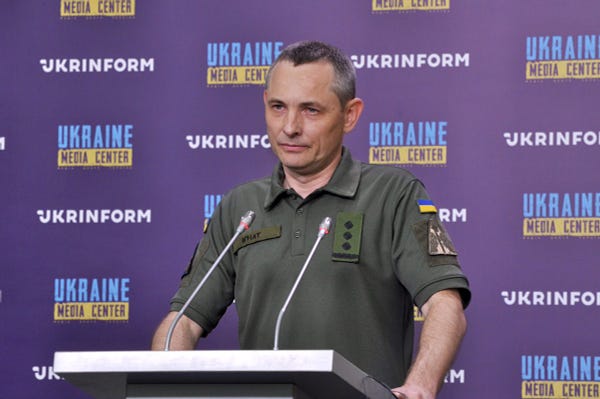
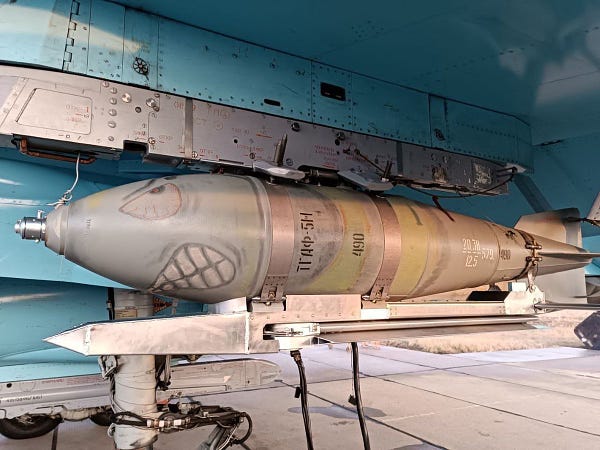
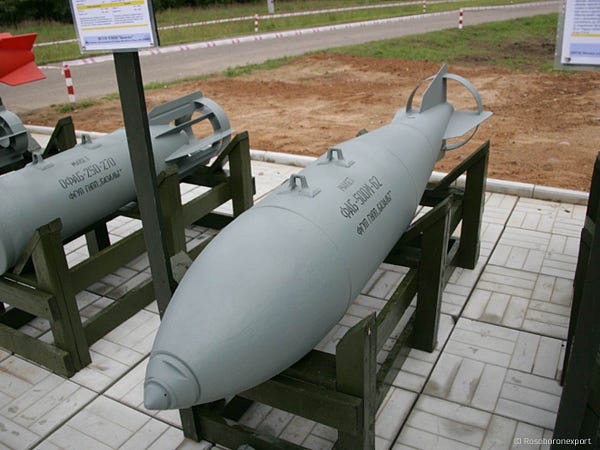
"They have enough FABs, They just add wings and GPS, and that's it. They are there, they just need to be upgraded. The cost of the issue is much less than to produce missiles."
He says Russia has tons of old FAB bombs to which they’re adding these UMPC (“Unified Planning And Correction Module”) units to turn them into quick, accurate JDAM-ER equivalents.
And this is being corroborated more and more from the frontlines, where a multitude of recent reports has shown destroyed AFU positions in places like Avdeevka and Kremennaya which were bombed from the air, showing that in general, with the continued degradation of AFU’s AD capabilities, the Russian airforce is having an increasingly impactful role on the contact line: VIDEO 1 (Alt link), VIDEO 2.
And speaking of supply line destruction, yesterday’s destruction by Wagner forces of an entire AFU convoy in northwest Bakhmut is also quite noteworthy: VIDEO (Alt link: VIDEO)
It has been geolocated to exactly this point circled in red here:
To get a more granular view of Bakhmut, we can see that even the pro-Ukrainian channels like this one are showing the entire southern end of Bakhmut as being captured:
It constitutes a map of the southern city roughly like this:
And as the video above shows, many of the positions have in fact been confirmed by geolocation of videos where Russian troops were seen fighting. You can even see in the above map that there is a section there near the stadium which is falling into a mini-boiler, which will likely lead to that entire neighborhood being captured in the near future.
In fact a new update as of this writing states that Wagner is currently storming this area as we speak:
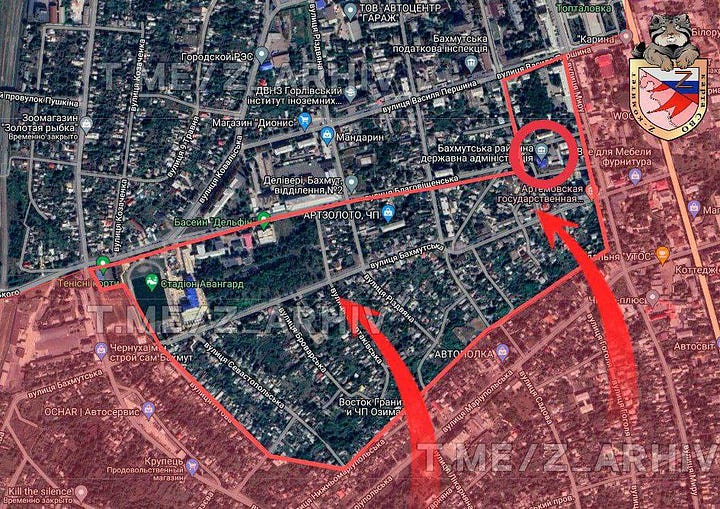

A certain military principle tells us that the tighter they squeeze the AFU in this small remaining center of Bakhmut, the faster the remainder will fall. This is because the AFU stuffed in this small central boiler are now flanked and surrounded on all sides. And when Wagner’s southern positions are a mere 1.5km from their own northern positions at the eastern edge then it puts the AFU in this quadrant in a sort of killbox enfilade situation that is disastrous to hold on to.
I’ve mentioned the maps before, but for those who want to follow along these are the two best updated maps: Map 1 and https://geoworld.space/ukraine/.
**
Now onto related news. Firstly to quell some worries about whether Russia might someday stop the military operation and compromise diplomatically, Dmitry Peskov stated the following:
Kremlin: SMO goals cannot be achieved through diplomacy, they will be achieved militarily
The Kremlin declared that it was impossible to achieve the goals of the special military operation through political and diplomatic means. This was stated by the press secretary of the President of Russia Dmitry Peskov.
📝“We have repeatedly said that the goals of the Russian Federation can be achieved in various ways - this is political-diplomatic or military, if political-diplomatic means are currently impossible,” Peskov told reporters.
At the same time, he noted that, since in the case of Ukraine it is impossible to achieve the goals of the special operation through diplomacy, they will be achieved through military means.
Secretary of Russian Secretary Council Patrushev echoed these words as well, in his own statement:
"Despite the steadily increasing military assistance to Ukraine from the United States and other Western states, all the declared goals of the special military operation will certainly be achieved. We will achieve the demilitarization and denazification of Ukraine, ensure the territorial integrity of the Russian Federation and the security of our population."
It appears Russian siloviki are still signaling maximalist intentions, which is a good sign.
Ukraine’s defense minister Reznikov on the other hand confirmed that Ukraine is preparing a counter-offensive ‘corps’. This is telling as a corps is generally 2-5 divisions, which themselves are 2-5 brigades of up to 5,000 troops each. So a corps can be upwards of 100k+ men. And this is in the ballpark of the figure that’s been discussed, with some having it at 120k+ which will be set for the ‘grand new Spring counter offensives’ in the south.
With that said, one must remember that, as scary as this figure sounds, the equally ‘grand Kherson counter-offensives’ Ukraine attempted several times, were on the order of 70-80k men and failed horribly without even budging a tiny Russian garrison.
Sure the Spring offensive is meant to be prosecuted with the latest Western gear, but at the same time one can argue it’ll involve mostly untrained conscripts since most of the experienced AFU have already been killed off. Not to mention the fact that all the currently delivered Western gear, as we know it at least, is fairly minimal.
Just look at the list below. The left column shows the tanks promised by each country, the right column shows what was actually cleared for sending or delivered.
The Polish T-72’s is already old news from last year, that hasn’t helped them much. But look at the totals for all the rest. I see maybe enough for 2-3 tank battalions at most, and that’s taking into account AMX-10 which isn’t even a real tank and has a putrid 105mm barrel.
With that said, this list doesn’t include the light armor, of which we know they’ve received a lot including Strykers, Bradleys, Marders, etc. And Ukraine did pull off the Kharkov offensive mostly with light armor, but that was against mostly lightly armed volunteer garrisons. Facing the brunt of Russian forces with the above is not a favorable prospect.
Here’s what interesting news a Rybar report brings on that front:
On the removal from storage of old equipment and weapons of the US Army and National Guard.
Our sources in the US state of Des Moines, Iowa, report that military equipment belonging to the US National Guard forces is now being actively repainted from sand to green and is being prepared for shipment to Ukraine.
A similar process takes place at the US Army Reserve storage facility next to the Fort des Moines Military History Museum: combat vehicles are repaired, put in working condition and taken to an unknown destination.
Absolutely everything that can be adjusted and repaired is taken from the balance of various units, including old communications equipment, uniforms and ammunition. At the same time, this situation affected not only storage databases.
❗️A couple of days ago, two exhibition M119 towed howitzers were removed from the US Army Museum in Des Moines, installed at the entrance to the military historical cultural site. For transportation, the same tactical Oshkosh vehicles were used that were used to remove equipment from army and National Guard units.Currently, the Armed Forces of Ukraine form more than a dozen assault brigades, focusing on the high mobility of armored groups by using wheeled armored vehicles, including the French AMX-10, the American Bradley infantry fighting vehicles and the German Marders. The presence of a sufficient number of light and maneuverable howitzers with HMMWV-based tractors will provide fire support to the advancing formations.
At the same time, the seizure of two museum copies indicates either a serious shortage of field artillery on the balance sheet of the American army, or an elementary reluctance to transfer the most modern models of the 105-mm M119A3 in service to the Armed Forces of Ukraine.
So on one hand, the US appears to be scraping the bottom of the barrel to get artillery systems to Ukraine, even possibly removing museum pieces to do so. But on the other hand Ukraine reportedly has formed upwards of 12 ‘assault brigades’, though of mostly light armor.
Also, the first photo showing a Ukrainian Leopard 2A4 with the oldest Russian Kontakt-1 reactive armor slapped onto it has appeared:
And for those who continue wondering if Russia is hitting these tanks as they’re accumulating in Ukraine, a new unconfirmed report stated the following:
Not far from the city of Zaporozhye, Western-made tanks were destroyed in one inconspicuous hangar tonight.
Quantity up to 10 units eyewitnesses could not say the exact model, they do not understand. But we saw how equipment was driven into the hangar and how our rocket flew there. @rtrdobetsk
As for the U.S., their own attempt to match Russia’s hypersonic capabilities has once again failed:
In fact after the debacle, the entire AGM-183 ARRW program appeared to die on the coals:
And as for the Black Sea Reaper surveillance situation. The US has now admitted that having been pushed back a further 70km by Russia is a great pain to them, as it ‘limits their intel gathering’.
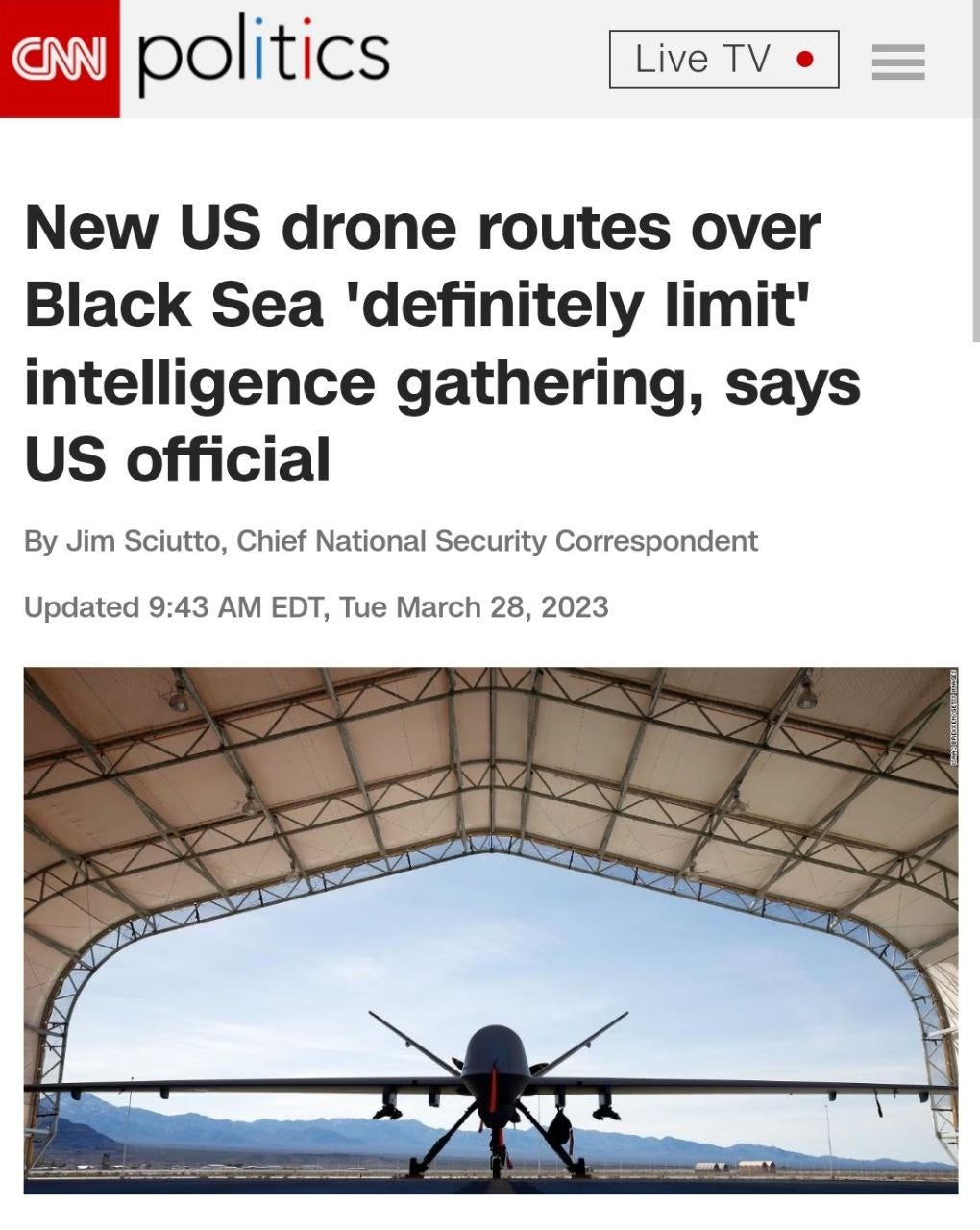
This confirms for us that, despite the little stage-managed one-time show of force by the UK last week where they flew with an armed Typhoon escort, NATO forces are in fact now afraid to fly their old routes and are forced to settle at much farther distances.
But the CNN article also had some insightful morsels:
The US decision to fly its surveillance drones further south over the Black Sea after a Russian jet collided with a US drone earlier this month “definitely limits our ability to gather intelligence” related to the Ukraine war, a senior US military official tells CNN.
Flying drones at greater distances reduces the quality of intelligence they can gather, a US military official explained, noting that spy satellites can compensate to some degree but have shorter times over targets, again reducing effectiveness relative to surveillance drones.
It’s a small confirmation that US’s own space ISR capabilities are not infallible or omniscient. As I highlighted in a previous article, the US only has a total of 6 massive, expensive Keyhole electro-optical recon sats, and Russia now has 5. These take up to 2 hours to orbit the earth, which means even with 6 of them, plus some Maxar and other commercial satellites, you’re only getting intermittent coverage.
Sure they have plenty of other non electro-optical (camera/telescope spy sats), like with SARs radar and signal gathering ones, but those are of less usefulness in many ways. They are more useful for detecting certain types of objects like perhaps radar installations whose electromagnetic radiation they can read from space, but for the vast majority of Russian military units they aren’t as useful as good old photo recon, particularly because SAR also has a lot of limitations/drawbacks, like the fact that it can’t really photograph objects in motion so any moving column of troops or armor will just appear as an un-identifiable blur/smear at best or literally invisible at worst, which includes flying craft, etc.
In the wake of the collision with the US MQ-9 Reaper drone on March 14, US officials have repeatedly said that the US would continue to fly in international airspace. However, the new routes place those flights more than 40 nautical miles from the Ukrainian coast, rather than the 12 nautical miles normally recognized as the limit of a nation’s airspace.
Boohoo, only the galling US can possibly cry about being 40 nautical miles away from someone’s border, rather than their ‘preferred’ 12.
After the Russian jet collided with a US Reaper drone earlier this month, the US began flying its surveillance drones further south and at a higher altitude over the Black Sea than previously, placing them further away from airspace surrounding the Crimean peninsula and eastern portions of the Black Sea.
When CNN first reported this change, one US official said the new routes were part of an effort “to avoid being too provocative,” as the Biden administration continues to be careful to avoid any incident that could escalate into a direct conflict with Russian forces. The official said the drone flights would continue this way “for the time being,” but added there is already “an appetite” to return to the routes closer to Russian-held territory.
Lucky for us, US is so adept at controlling its ‘appetites’ for war, said he with a roll of the eyes.
Last in the ‘interesting tidbits’ section, we’ve had the first confirmation from Russian MoD that Russia has reportedly shot down a Ukrainian GLSDB (Ground Launched Small Diameter Bomb). The bigger news is not that Russia was able to shoot it down, which is something I covered in much depth here:
But the simple confirmation that Ukraine has in fact taken delivery of them, which means it now has the ability to hit upwards of 150km.
The Ministry of Defense of the Russian Federation for the first time reported a GLSDB guided projectile shot down in the NVO zone (“smart” aircraft bomb with an engine)
However, this is not 100% confirmation that they are in theater. Spokesman Konashenkov has made some small mistakes in reporting things in the past and there’s likely no definitive way for them to know what it was they shot down, unless they in fact have recovered parts of it, of which I am not aware.
Pentagon spokesman John Kirby for his part answered this report with:
John Kirby: "I can't confirm Russian reports that they took one of these down. We're not able to confirm that. But we are already committed to being able to provide that capability to Ukraine"
And another source stated that Boeing has only just begun production of the GLSDB and is not slated to even arrive in Ukraine until end of 2023. This feels more likely to me, particularly because if Ukraine really had GLSDB’s they would have probably used them more en masse by now, and in fact they’re hardly even firing HIMARs at all anymore, much less GLSDB’s and other fancy things like that.
Well, that’s all for today folks, see you next time.









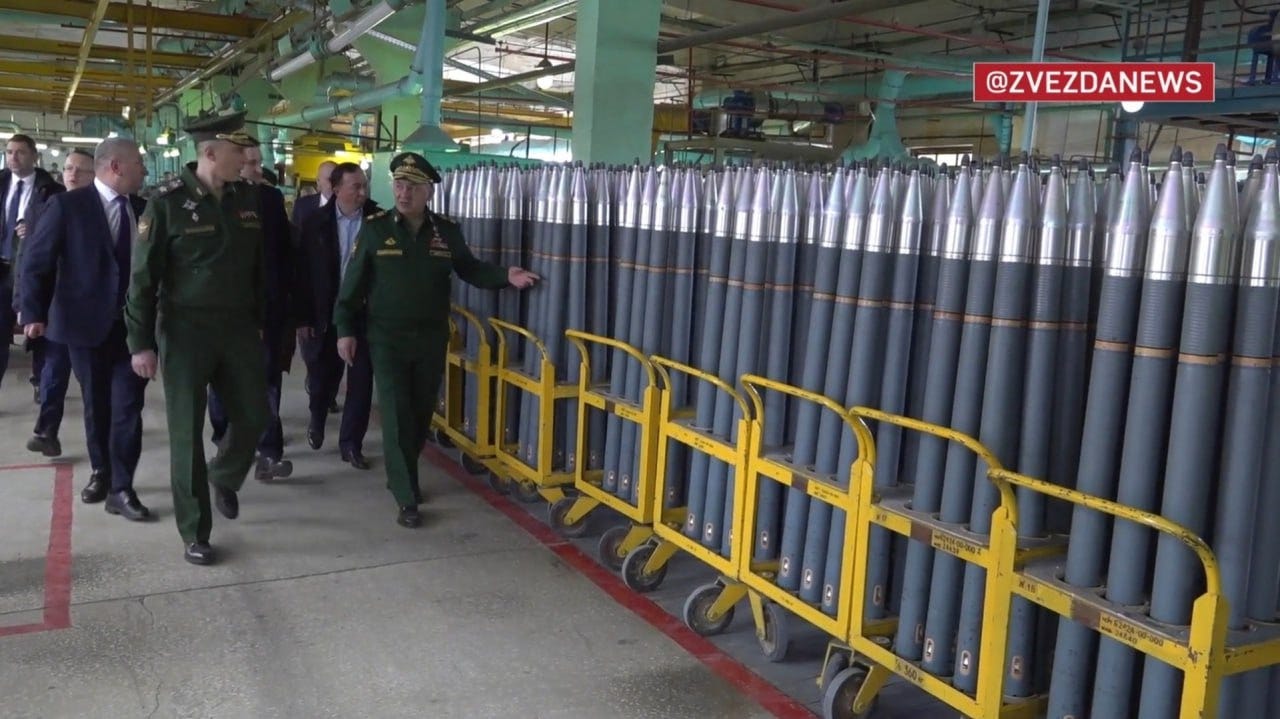

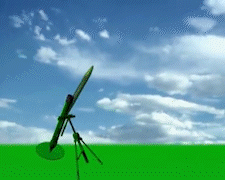
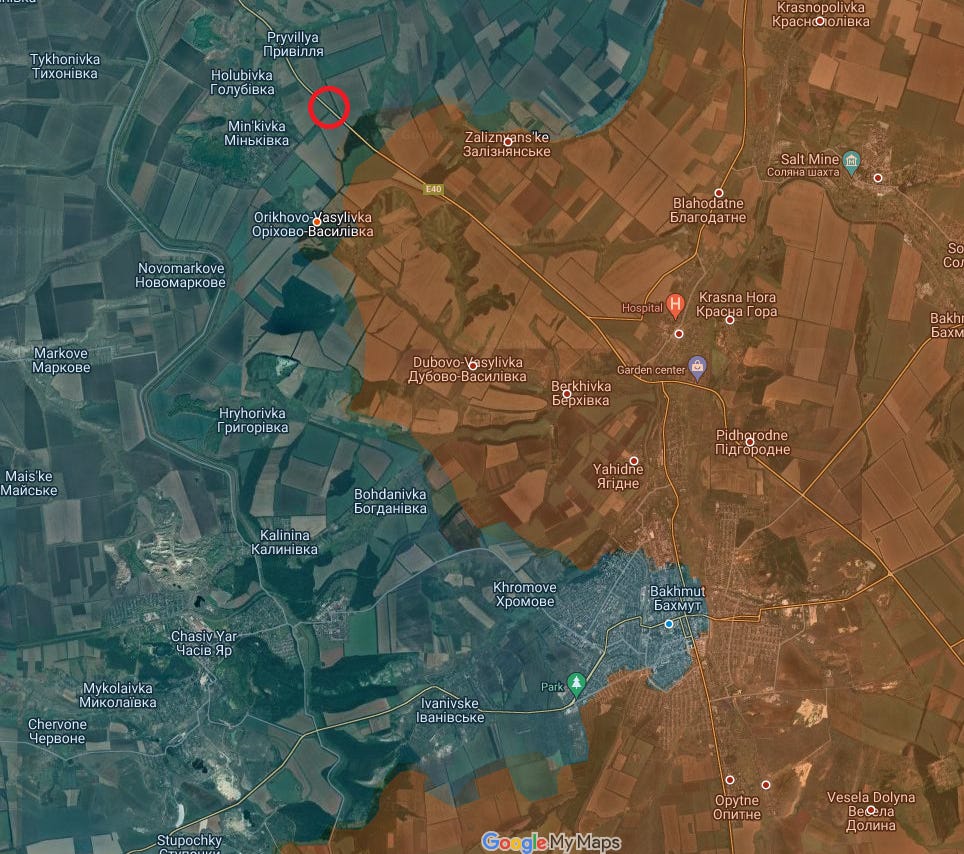
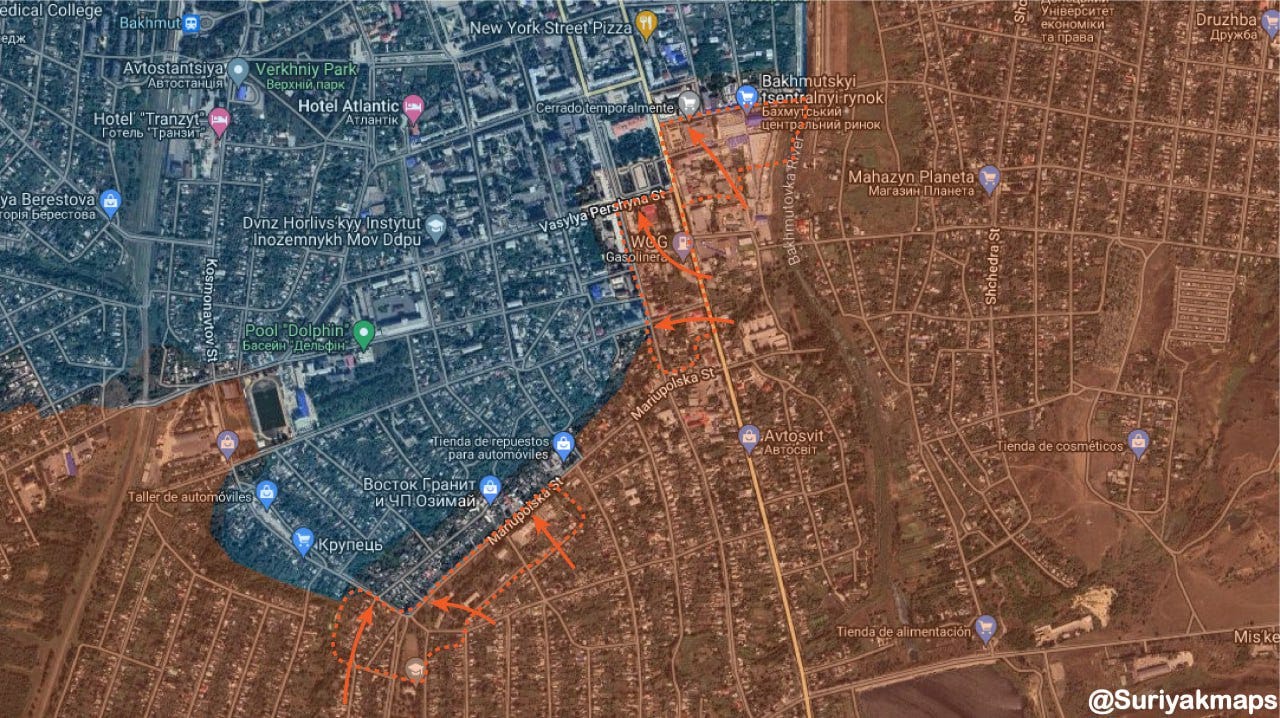
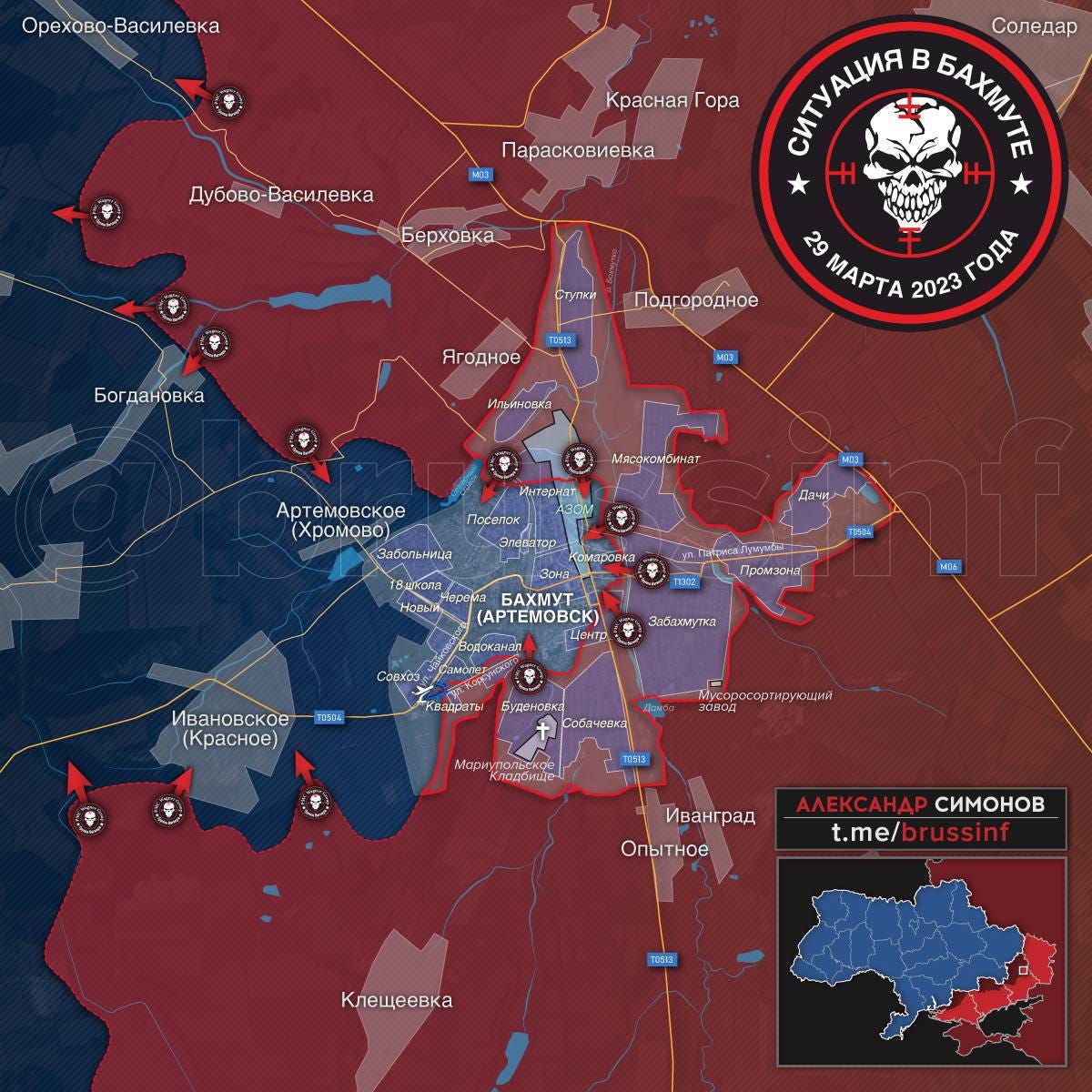

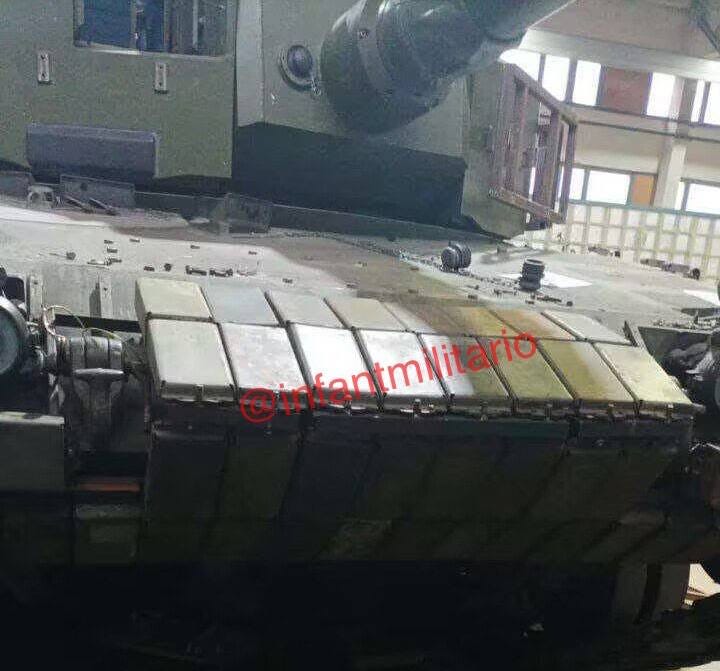



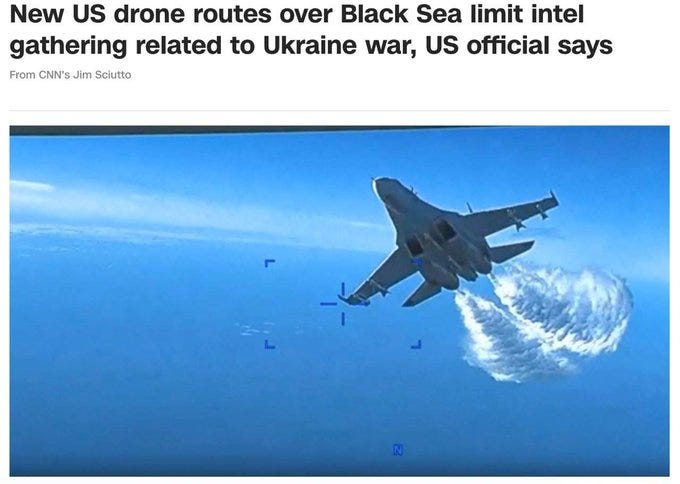

As always great work!!! Thank you so much!!
Very informative. I always look forward to your updates.